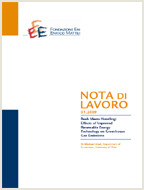The Role of Outliers and Oil Price Shocks on Volatility of Metal Prices

Data
07.09.2015
07.09.2015
Autori
Niaz Bashiri Behmiri (Fondazione Eni Enrico Mattei); Matteo Manera (University of Milan-Bicocca, Fondazione Eni Enrico Mattei)
Codice JEL
G13, Q4, C1
G13, Q4, C1
Parole chiave:
Metals, Commodities, Volatility, Oil Price, Outliers
Metals, Commodities, Volatility, Oil Price, Outliers
Publisher
Energy: Resources and Markets
Energy: Resources and Markets
Editor
Matteo Manera
Matteo Manera
This study investigates the price volatility of metals, using the GARCH and GJR models. First we examine the persistence of volatility and the leverage effect across metal markets taking into account the presence of outliers, and second we estimate the effects of oil price shocks on the price volatility of metals, allowing for the asymmetric responses. We use daily spot prices for the selected metals, including aluminum, copper, lead, nickel, tin, zinc, gold, silver, palladium and platinum. The main findings indicate that, returns show a high degree of volatility persistence before and after correcting outliers, outliers bias the parameters estimation of the GARCH-type models, and removing outliers improves the performance of models in capturing volatility. However in a comparison, Student-t distribution outperforms the approach of correcting outliers in capturing volatility. Moreover, we find the existence of inverse leverage effect for seven metals, the leverage effect for copper and no leverage effect for nickel and palladium. Finally, price volatility of metals differently reacts to oil price shocks and there is an asymmetric reaction of volatility to oil price shocks for seven metals.
***
Suggested citation: Niaz Bashiri Behmiri, Matteo Manera, The role of outliers and oil price shocks on volatility of metal prices, Resources Policy, Volume 46, Part 2, December 2015, Pages 139-150, ISSN 0301-4207, http://dx.doi.org/10.1016/j.resourpol.2015.09.004.
